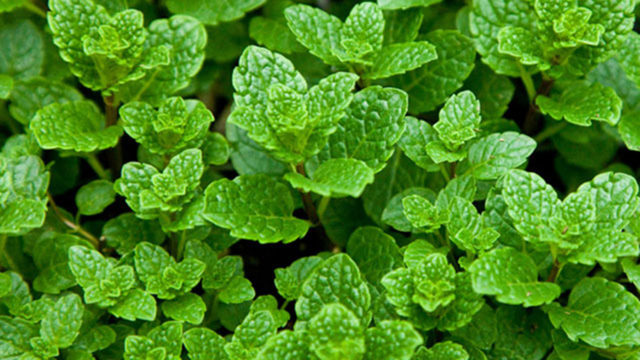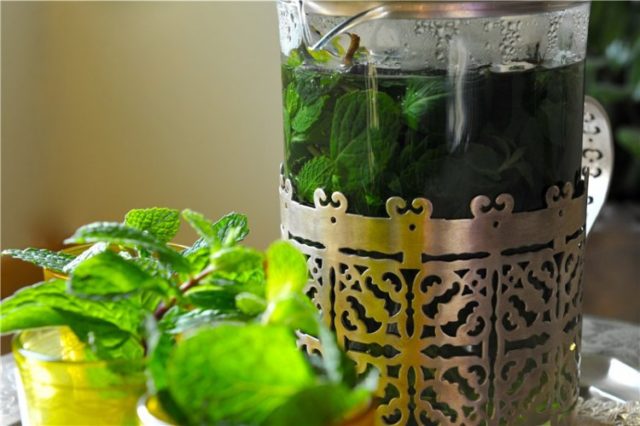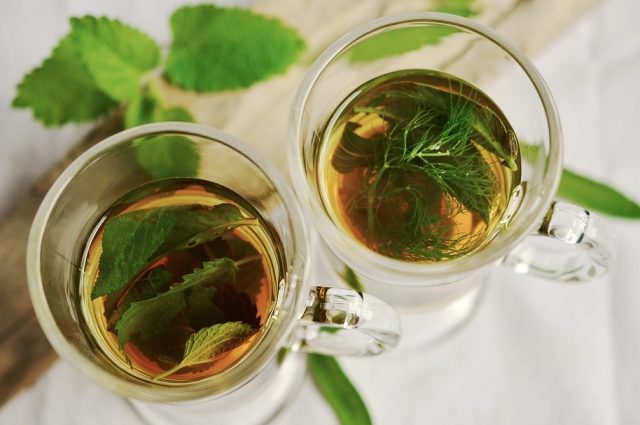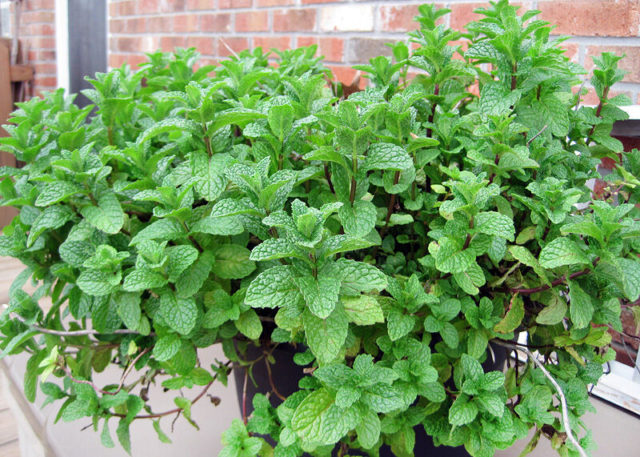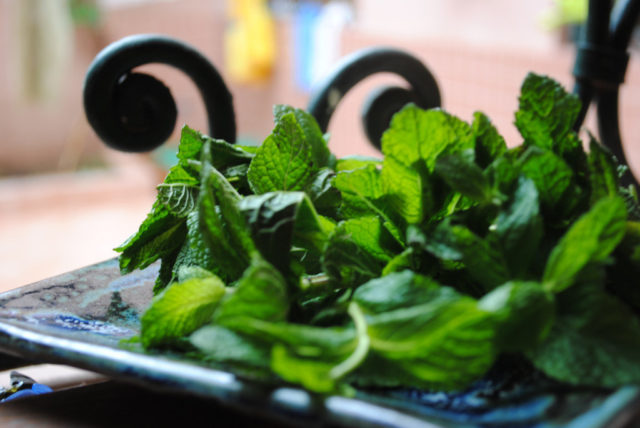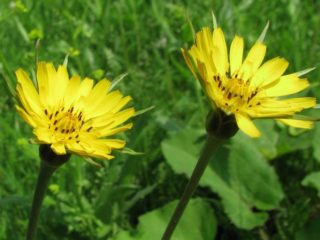Content
Moroccan mint is a variety that has a milder aroma and flavor than the more common peppermint. You can grow it at home, and the scope of application of mint leaves is very wide.
Description of Moroccan mint
Moroccan mint is a species of spearmint and is native to North Africa, Western Asia and southeastern Europe. The plant has a rather compact size up to 60 cm in height. The stems of the plant are erect, the leaves are embossed, wrinkled, with sharp notches along the edges and pubescence along the surface. The color of the leaves is dark green.
The use of Moroccan mint in cooking
It is Moroccan mint that is most often used for culinary purposes. It is more popular than pepper because it tastes softer and less scalding.
What is the flavor of Moroccan mint
Connoisseurs of the plant especially note its extraordinary aroma. The herb gives off a refreshing, cold and at the same time sweetish smell.
Where can Moroccan mint be added?
Mostly Moroccan mint is used in the preparation of drinks. It is added to cold fruit and alcoholic cocktails, hot teas and other drinks; mint leaves are widely used in the preparation of mojitos.
You can also decorate a vegetable or fruit salad with Moroccan mint, give an unusual flavor and aroma to hot meat dishes. The plant is used to create desserts. Mint, combined with sweet ingredients, creates particularly original flavor combinations.
The healing properties of Moroccan mint
The plant is prized not only for its pleasant aroma and taste, but also for its health benefits. The plant contains vitamins and organic acids, essential oils and menthol, mineral components and antioxidants. Due to this, Moroccan mint:
- has anti-inflammatory properties;
- accelerates blood circulation and improves brain function;
- stimulates the intestines and metabolic system;
- has a mild analgesic effect;
- helps to relax and calm down;
- normalizes sleep;
- relieves muscle spasms.
Mint is of great benefit in depressive conditions, it helps to improve mood and tone.
Application in traditional medicine
The benefits and harms of Moroccan mint are widely used in home medicine recipes. With its help they treat:
- colds and coughs;
- gastric and intestinal disorders;
- sleep disorders, depression and anxiety;
- malfunctions of the exchange system;
- joint and headaches.
Moroccan mint helps with hypertension and chronic migraines.
Recipes for infusions, decoctions, tinctures on Moroccan mint
There are several basic ways to process and prepare mint leaves.Some of them suggest using alcohol, others allow you to prepare aqueous products.
Moroccan mint decoctions
The classic Moroccan mint decoction is prepared as follows:
- Chop 2 large spoons of fresh or dried leaves;
- pour a glass of cool clean water;
- heated in a water bath under a lid;
- as soon as the mint starts to boil, it is removed and cooled.
You can also prepare a decoction with mint and additional ingredients. This requires:
- take 2 large spoons of mint leaves;
- add half a cinnamon stick and a slice of fresh lemon to them;
- put a couple of dried cloves buds;
- pour the ingredients with water and steam to almost boil, but turn off until bubbles appear.
Both versions of the broth are well suited for the treatment of colds and intestinal ailments. You need to drink mint warm on a full stomach, it is recommended to drink no more than 2 cups per day.
Infusions on Moroccan mint
The recipe for a classic mint infusion looks like this:
- mint in the amount of 2 large spoons is poured into a small container;
- pour raw materials with a glass of boiling water;
- cover with a lid and wrap with a thick cloth;
- wait until the infusion has completely cooled down, and then filter and drink.
Another version of the infusion suggests combining mint with other medicinal herbs. For example, you can prepare the following collection:
- mint, chamomile and thyme are mixed in equal amounts;
- 2 large spoons of medicinal herbs are poured with water at about 80 ° C;
- cover the container with a lid and infuse the product until it cools completely.
The finished infusion is filtered and added to tea or slightly diluted with clean water. Infusions on Moroccan mint help with poor digestion, calm the nerves well and eliminate insomnia.
Alcoholic tinctures of mint
Mint on alcohol has strong medicinal agents, the beneficial substances in the plant are especially well soluble in an alcoholic base. The simplest tincture recipe offers:
- chop 100 g of fresh mint leaves;
- pour raw materials with 500 ml of vodka or alcohol;
- remove the product in a dark place for 3 weeks.
The vessel is shaken daily, and after the expiration of the period, the tincture is filtered and stored in the refrigerator.
Another recipe suggests using sugar to make the tincture. In this case, the drink will turn out to be not only useful, but also pleasant to the taste. They do it like this:
- 50 g of fresh mint is chopped;
- pour raw materials with 500 ml of vodka;
- insist the remedy for 45 days in a dark place;
- upon reaching full readiness, filter the tincture and add 50-100 g of sugar to it to taste.
After that, the tincture must be removed to a dark place for another week, and then filtered.
Tincture on Moroccan mint has an excellent effect on migraines and joint pains - it is used to rub the limbs or temples. With a diluted tincture, you can rinse your mouth and throat for inflammation and colds, and for intestinal ailments, it is allowed to add 15 drops of the product to a glass of water and drink it on an empty stomach to relieve pain and normalize digestion.
Limitations and contraindications
Despite the benefits of Moroccan mint, not everyone is allowed to use it. The plant must be abandoned:
- with hypotension and varicose veins;
- if you are allergic to menthol and any substances in the composition of mint;
- during pregnancy and during breastfeeding;
- with low acidity of the stomach.
It is not recommended to take mint infusions and decoctions with a decrease in libido in men, since the herb can aggravate the situation. Do not give Moroccan mint to children under 7 years old.
Growing Moroccan mint from seeds
You can grow Moroccan mint in your own garden. An interesting feature of the plant is that the southern mint tolerates the conditions of the middle lane well and calmly survives cold winters.Mint is grown from seeds, and you can buy them at the horticultural market or in a specialized store.
Recommended sowing dates
You can plant mint indoors at the end of February. Planting young shoots in the ground is carried out in early May after the establishment of warm temperatures. In this case, the soil should warm up to at least 10 ° C.
Site selection and soil preparation
It is customary to sow Moroccan mint seeds in small plastic containers with a lid in which holes are made for air access. This helps to create a mini greenhouse for the seeds and maintain the desired temperature conditions. The mint soil should be sandy, well-ventilated and moist, with a high calcium content. Seeds are laid in grooves 5 mm deep, and then sprinkled with soil and placed on a lighted warm windowsill.
When transplanting mint sprouts into open ground, you need to choose a sunny or semi-shaded area on the site. A week before planting, the soil is weeded and weeds are removed, and then a mixture of humus and compost with the addition of wood ash is added to the soil in the selected area. The day before planting, the soil can be spilled with a manganese solution to disinfect the soil.
How to plant correctly
Before planting, young mint sprouts are carefully removed from the containers and dipped in a stimulating solution for half an hour.
In the selected area, small pits are dug 5 cm deep, the distance between the individual holes is left at least 15 cm.The sprouts are lowered into the pits and the roots are gently straightened, and then covered with soil and watered abundantly. It usually takes 15-20 days for Moroccan mint to take root, after which new young leaves are formed.
Features of growing Moroccan mint
Moroccan mint is a moisture-loving plant; when growing it, you need to ensure that the soil always remains slightly moist. The beds with mint are usually irrigated once in spring and autumn, and during the summer heat, watering is increased up to 3 times a week. The land under the mint bushes should be mulched with sawdust or peat, this will prevent rapid evaporation of water.
From time to time, the soil in which a useful plant grows must be weeded and loosened. The procedures allow you to remove weeds, which take useful substances from mint, and improve the air permeability of the soil. You need to loosen the ground carefully and shallowly so as not to damage the roots of the plant.
Pests and diseases
In the garden, Moroccan mint most often suffers from rust and powdery mildew - orange and brown spots or whitish bloom appear on the leaves. Ailments develop most often due to a lack of space between individual bushes or due to non-compliance with watering rules. Also, mint can suffer from pests such as aphids, weevils and whiteflies.
Treatment of Moroccan mint is carried out with standard insecticidal and fungicidal mixtures - Bordeaux liquid, Aktara, Topaz. All affected parts of the plant are cut and burned.
When and how to harvest Moroccan mint for medicinal purposes
Collecting fresh mint leaves is recommended in the spring, before the flowering of the fragrant plant. At the end of May or at the beginning of June, mint already has time to accumulate a maximum of useful substances and essential compounds in its leaves. The mint leaves of the first year of growth are most beneficial.
For collecting leaves, it is recommended to choose a cloudy day without bright sunlight. The leaves are carefully cut with a knife, and then washed in cold water and dried on a paper towel.
How to dry Moroccan mint properly
For long-term storage, mint leaves are usually dried. This is easy to do - they need to be laid out in the shade on a flat surface with a thin layer, and then left for several days in the fresh air. The readiness of the leaves is determined by touch: if the mint begins to crumble in the fingers, it means that all the moisture from it has evaporated.
The dried leaves are ground into powder or broken into small pieces. You need to store mint in a wooden or glass container in a dry place, protected from sunlight, and it retains its beneficial properties for about 2 years.
Conclusion
Moroccan mint is a healthy plant with a very pleasant taste and aroma. You can grow mint on your own plot, and its leaves are used both for treating ailments and for preparing drinks or culinary dishes.
